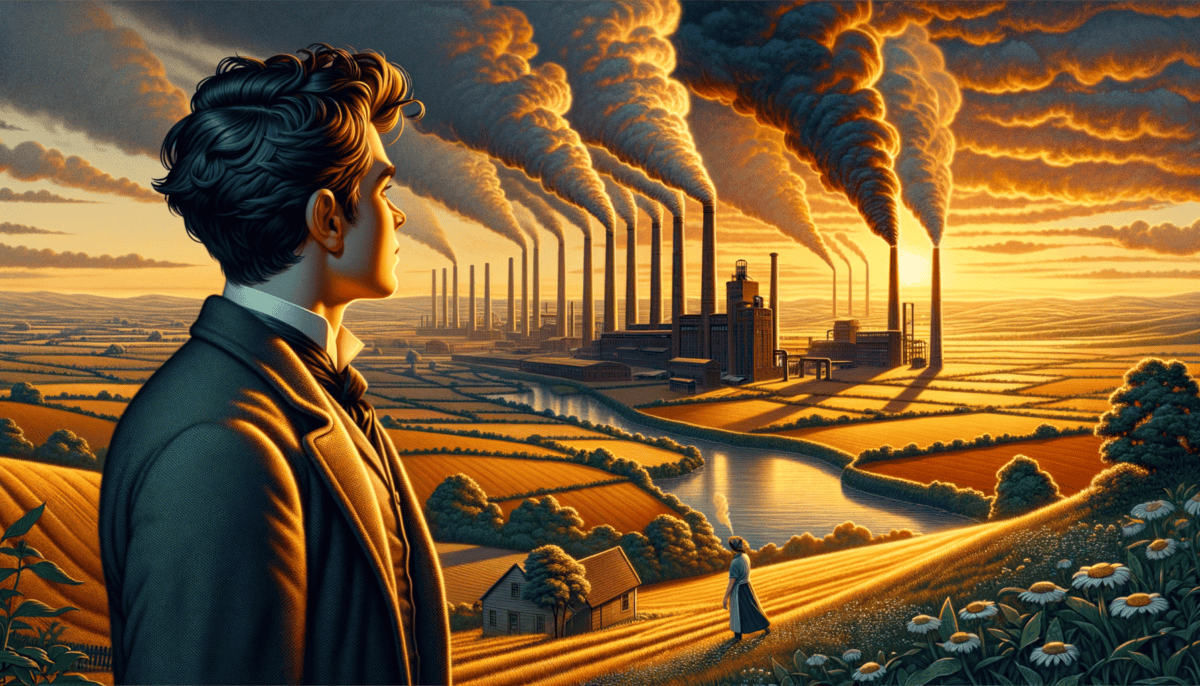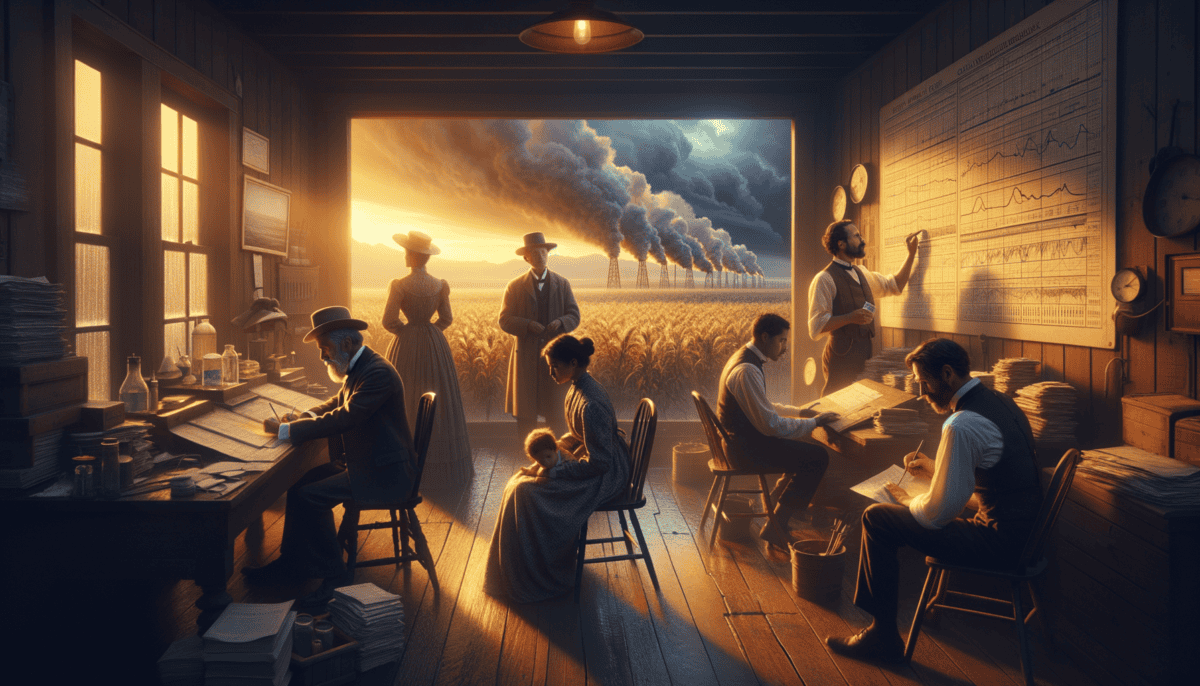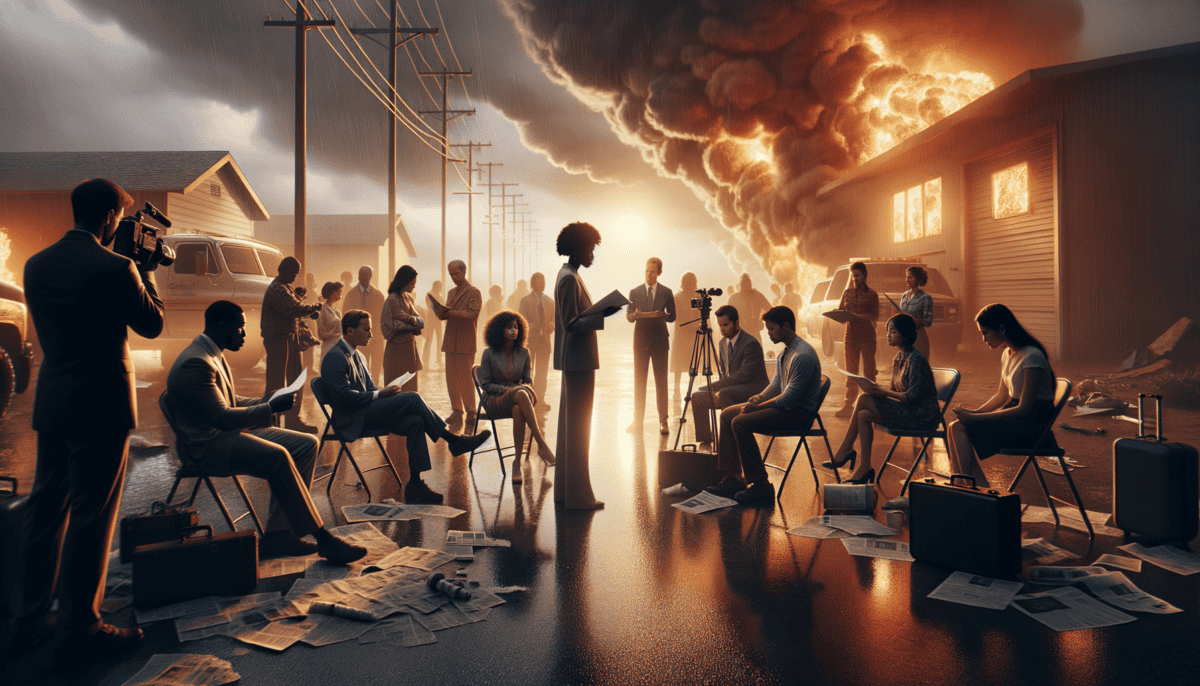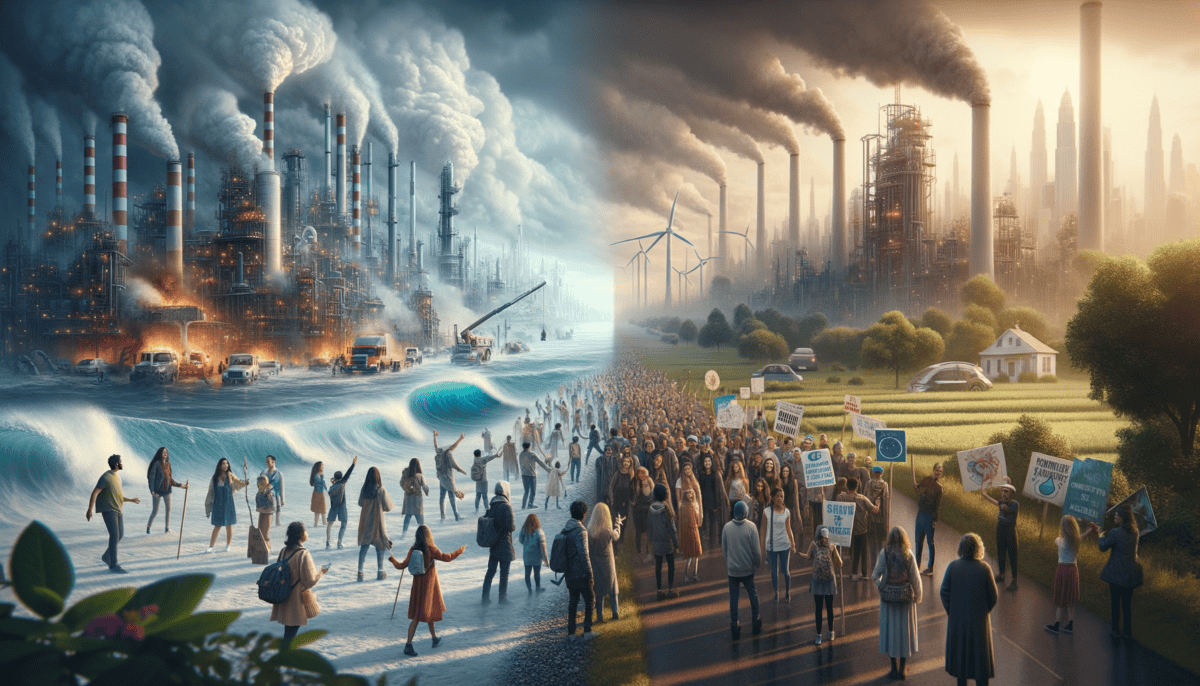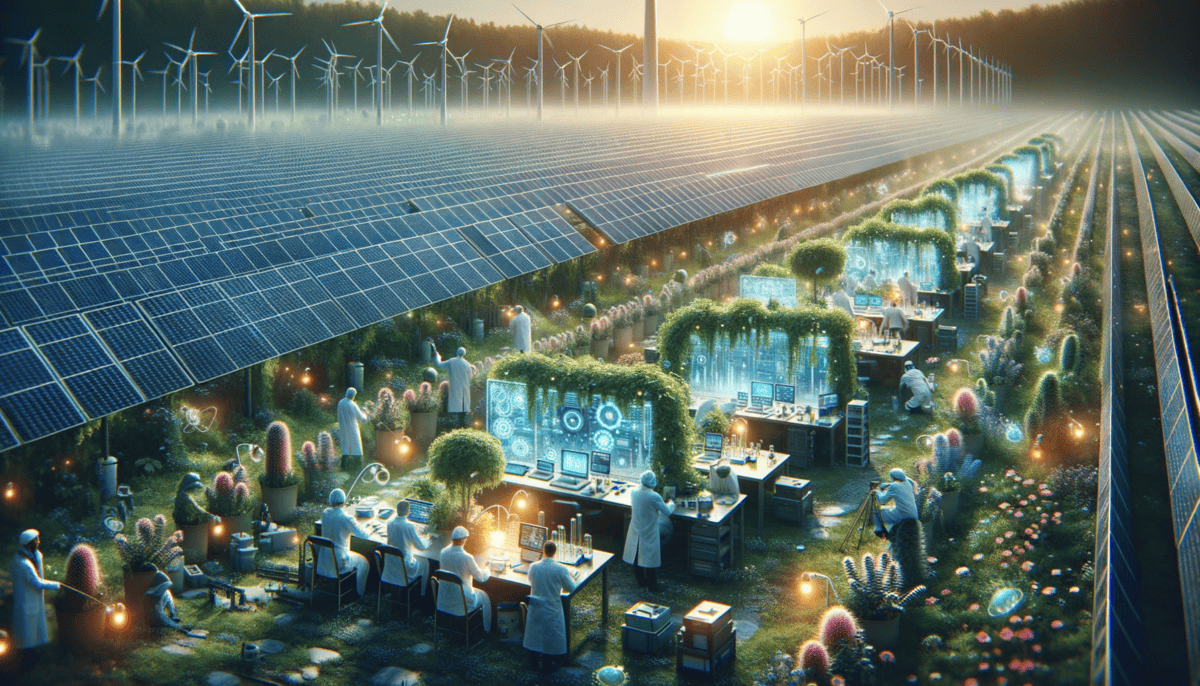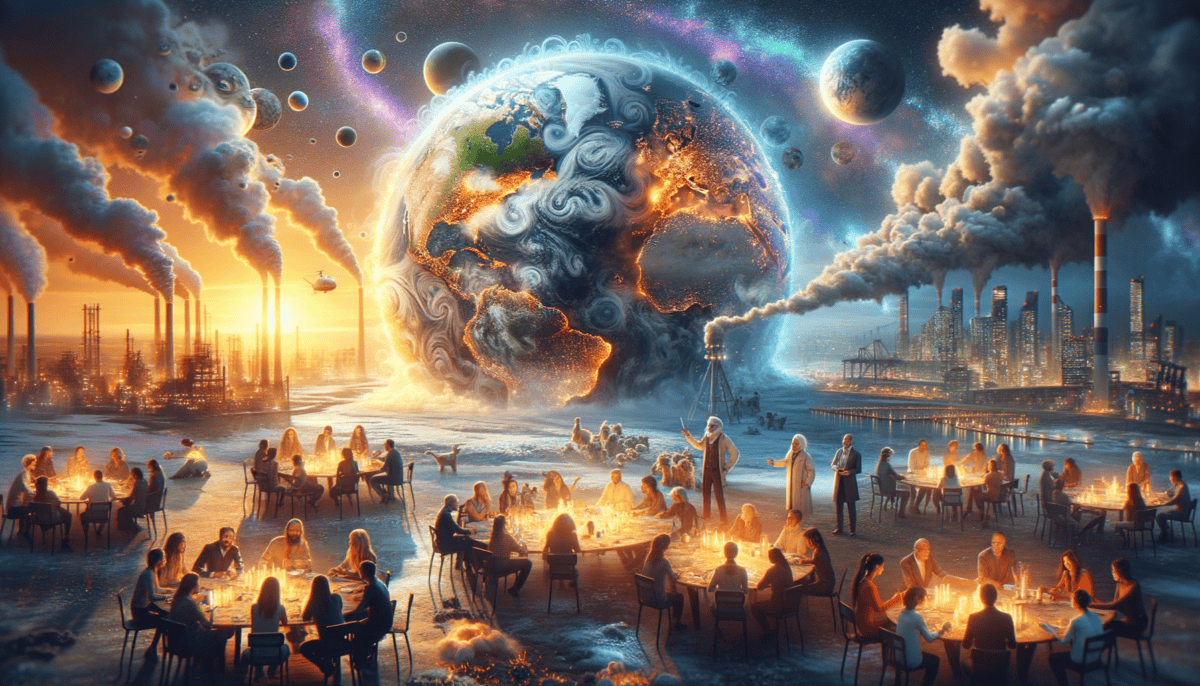The Industrial Whispers
The city was covered in a gray blanket of smoke. Thomas watched from his tiny workshop window as tall chimneys puffed dark clouds into the sky. He was only twelve, but he knew something wasn’t quite right.
“The air didn’t always look like this,” his grandmother would say. “When I was young, we could see the stars at night.”
Thomas picked up his latest invention – a small wind-powered toy. He loved making things that didn’t need coal or steam to work. His friend Elizabeth worked in one of the big factories, and she always came home with black smudges on her face.
One day, Elizabeth rushed into Thomas’s workshop, her eyes wide with excitement. “Thomas! The factory owner wants to see your wind toy! He says it might help make the air cleaner!”
Thomas felt his heart jump. “Really? But my toy is so small…”
“Big ideas start small,” Elizabeth smiled, wiping soot from her cheek. “Just like how small changes in the weather can lead to bigger changes.”
They noticed more changes that year:
• The snow came later than usual
• The flowers bloomed at strange times
• The air felt warmer, even in winter
• The rain seemed different – sometimes too much, sometimes too little
Thomas and Elizabeth started keeping a weather diary. Every day, they wrote down what they saw:
Tuesday: Warm wind from the factories.
Wednesday: Yellow snow near the coal yard.
Thursday: Birds flying away earlier this year.”
One evening, as they sat by Thomas’s window, Elizabeth pointed to the factory chimneys. “Do you think all that smoke is changing our weather?”
Thomas looked at his wind toy spinning gently. “I think it is. And I think we need to find a better way.”
Nature was trying to tell them something important. The weather was changing, and the smoke from the factories had something to do with it.
That night, Thomas drew plans for bigger wind-powered machines. He dreamed of factories that didn’t need coal, of clear skies where stars could shine again. Elizabeth promised to help him test his ideas.
The next morning, as Thomas walked to his workshop, he noticed something different. Through a break in the smoke, he saw a patch of bright blue sky. It reminded him that nature was still there, waiting for humans to learn how to live in harmony with it.
“We’ll find a way,” he whispered to himself, clutching his notebook of ideas. “We have to.”
Rising Temperatures, Rising Concerns
️ Many years after Thomas and Elizabeth first noticed the changing weather, a curious scientist named Sarah lived in a small coastal town. She had a special thermometer that she used every day to measure the temperature.
“The numbers keep getting higher,” Sarah would tell her daughter Maya. “The Earth is getting warmer, like a blanket is wrapped around it.”
Maya loved helping her mom record temperatures in their big red notebook. She noticed that their garden was different from the pictures in her grandmother’s old photo albums.
One hot summer day, Maya and her friend Jack sat under their favorite apple tree. The apples were ripening much earlier than usual.
“My dad says the fish are swimming in different places now,” Jack said, fanning himself with his hat. “The water’s getting too warm where they used to live.”
Sarah noticed these changes too. She started a list of what was different:
• Flowers blooming earlier in spring
• Less snow in winter
• More rainy days
• Hotter summers than ever before
• Some animals moving to new homes
Maya helped her mom share their findings with other scientists. They used special computers to understand what was happening. The numbers told an important story.
One evening, while looking through their temperature records, Maya had an idea. “Mom, what if we make a picture book to help other kids understand what’s happening?”
Together, they created colorful drawings showing how the Earth was changing. They showed how warmer temperatures affected everything – from tiny insects to giant glaciers.
Sarah and Maya’s picture book traveled around the world. Other scientists started sharing their own stories and measurements. They were all seeing the same thing – the Earth was getting warmer.
“But why does it matter if it’s a little warmer?” Jack asked one day.
Maya thought about the fish in the warm ocean, the early apples, and the missing snow. “Because everything in nature is connected,” she answered. “When one thing changes, it affects everything else.”
That night, Sarah and Maya sat on their porch, looking at the stars through breaks in the clouds. They wondered what other changes they would see in the years to come.
“Knowledge is the first step to making things better,” Sarah said, hugging Maya close. “Now that we understand what’s happening, we can work on fixing it.”
The Weather Speaks Louder
️ The world had changed since Maya and Sarah first started measuring temperatures. Now, Maria, a young weather researcher, watched as storm clouds gathered more often than ever before.
“The weather is trying to tell us something,” Maria would say to her little brother Carlos. “We just need to listen carefully.”
Maria worked with a team that tracked big storms around the world. They used fancy computers and satellites to watch the weather from space. ️
One day, Carlos came running into Maria’s office. “Look at this!” He pointed to the TV showing news from different places around the world:
- Big rainstorms in places that used to be dry
- Less rain in places that needed it for farming
- Stronger hurricanes near the ocean
- More wildfires in hot places
- Melting ice at the North and South Poles
Maria helped Carlos understand what was happening. “It’s like when you shake a snow globe,” she explained. “The warmer Earth is making the weather more jumbled up.” ❄️
“The Earth is one big home we all share,” Maria answered. “When the temperature changes in one place, it affects weather everywhere else too.”
Maria and her team created a special map to show how the weather was changing. They used different colors to show where it was getting:
Much hotter than before
More rain and floods
Very dry with less rain
⚪ Less snow and ice
People from all over the world started sharing their weather stories with Maria’s team. A farmer in Africa told them about having less rain for his crops. A family in Asia talked about bigger floods near their home.
“Look at all these stories,” Carlos said, pointing to the computer screen. “It’s like the whole world is talking to us!”
Maria nodded. “And that’s why it’s so important that we work together to help our planet. Just like the weather connects us all, we need to connect with each other to make things better.”
They started a special weather club at Carlos’s school. Kids learned about different types of weather and how to stay safe during big storms. They even made their own small weather station! ⛈️
That evening, Maria and Carlos watched the sunset through partly cloudy skies. The weather was different from what their parents and grandparents knew, but they felt hopeful. More people were paying attention to the Earth’s messages now.
“The weather might be getting stronger,” Maria said, “but so are we. Together, we can face any storm that comes our way.”
Voices of Change
Maya watched excitedly as hundreds of kids filled the park. They carried colorful signs with pictures of the Earth and messages about helping our planet.
“The Earth needs our help now!” Maya shouted through her megaphone. Her friend Jack waved a big blue and green flag shaped like Earth.
Maya remembered how it all started. Last year, her teacher Mrs. Rodriguez taught the class about climate change.
“Even small actions can make big changes,” Mrs. Rodriguez explained. “Like planting trees or using less plastic.”
Maya and her friends started the “Green Heroes Club” at school. Every week, they did something new to help the Earth:
- Started a school garden
- ♻️ Set up recycling bins
- Rode bikes to school
- Reminded people to turn off lights
- Planted trees in the neighborhood
Other schools heard about their club and started their own. Soon, kids everywhere were becoming Green Heroes!
“What should we do first?” the mayor asked.
The Green Heroes had lots of ideas:
“Let’s put solar panels on buildings!”
“We can make more bike lanes!”
“How about growing food in community gardens?”
The mayor smiled. “These are wonderful ideas! Let’s work together to make them happen.”
Soon, the city was changing. Solar panels appeared on rooftops, catching the sun’s energy. New bike lanes helped people drive less. Community gardens sprouted up in empty lots.
Maya’s mom, a news reporter, did a story about the Green Heroes. People in other cities saw it and wanted to help too!
The movement grew bigger and bigger. Kids from different countries started talking to each other online, sharing ideas about helping the Earth:
Brazil: Saving rainforests
India: Cleaning rivers
Kenya: Growing trees
Australia: Protecting coral reefs
One day, Maya got invited to speak at a big meeting where grown-ups made important decisions about the Earth. She was nervous but excited.
“The Earth is our home,” Maya told them. “And we kids want to help take care of it. Will you help us?”
The grown-ups stood up and clapped. They promised to work harder to protect the Earth.
That night, Maya looked at the stars through her window. She thought about all the Green Heroes around the world, working together to make things better.
“We might be young,” she whispered, “but our voices are strong. And together, we can help save our Earth.”
Technology Meets Nature
Dr. Sarah walked into her bright solar-powered lab, where something amazing was happening. Her team was building new tools to help our Earth!
“Look what we made!” called out her assistant Rob, pointing to a shiny new solar panel that looked like a flower. “It follows the sun just like a real sunflower!”
Dr. Sarah smiled as she watched the solar flower turn its face toward the morning sun. She remembered when she was a little girl, dreaming of helping the Earth.
“Maybe someday you’ll figure out how,” her mom had answered.
Now, Dr. Sarah and her team were doing just that! They called their lab “The Earth Helper Station.” Here are some of their cool inventions:
- Solar flowers that make clean energy
- Wave riders that catch ocean power
- ️ Tiny windmills that spin in gentle breezes
- Special trees that clean the air extra fast
- Cars that run on sunshine
Their newest project was super exciting – they were teaching computers to help plants grow better!
“The computers are like plant doctors,” Rob explained to a group of visiting kids. “They help us grow more food using less water!”
The kids had lots of questions:
“Can the solar flowers power my whole house?”
“Do the wave riders hurt the fish?”
“Can I get a tiny windmill for my backyard?”
Dr. Sarah loved answering their questions. “These tools help us live in a way that’s friendly to nature,” she explained. ⭐
One day, a famous company visited their lab. They wanted to put Dr. Sarah’s inventions in cities all around the world!
Soon, Earth Helper Stations started popping up everywhere. Each one had its own special way of working with nature:
️ Mountain stations caught wind power
️ Beach stations used ocean waves
Desert stations soaked up sunshine
Forest stations planted smart trees
Best of all, the stations shared what they learned with each other. When someone found a better way to do something, everyone could try it!
“Nature is so smart,” Dr. Sarah often said. “When we work with it instead of against it, amazing things happen!”
The Earth seemed happier too. The air was getting cleaner, and there was more room for animals and plants to live. Cities looked prettier with their solar flowers and smart gardens.
Dr. Sarah’s favorite part was teaching kids about the Earth Helper Station. Maybe some of them would grow up to be scientists too!
“Remember,” she told them, “the best inventions are the ones that help both people and nature. That’s when real magic happens!” ✨
A New Day for Earth
The world looked different now. Solar flowers bloomed in city parks. Wind catchers danced on rooftops. The air felt fresher, and the sky seemed bluer.
“Look, Grandma!” little Maya pointed at a solar flower turning toward the sun. “It’s just like the ones Dr. Sarah made!”
Maya’s grandmother smiled. She remembered when the streets were full of smoky cars. Now, quiet solar-powered buses whispered past gardens growing on buildings.
In schools, kids learned about taking care of Earth in fun ways:
- Growing food in classroom gardens
- Making tiny solar toys
- ♻️ Turning old things into new treasures
- Planting trees in their neighborhoods
- Saving water with smart tools
Countries that used to argue were now working together to protect our Earth home.
“When we realized Earth was talking to us through the weather,” Grandma explained. “We just had to learn to listen.”
All around the world, good things were happening:
Whales were singing in cleaner oceans
Bees were buzzing in city gardens
Flowers were growing in old factory lots
Butterflies were dancing in new parks
“Earth is like a big garden,” Maya’s teacher said. “When we take care of it, everything grows better!”
Dr. Sarah’s Earth Helper Stations had grown into something bigger. Now, every neighborhood had its own way of helping:
Some people caught rainwater for gardens. Others made compost to help plants grow. Kids invented new ways to clean up trash from beaches.
Scientists made new earth-friendly tools
Teachers shared knowledge about nature
Kids came up with fresh ideas
Families worked together in their communities
Maya loved hearing stories about how things used to be, and how people changed them for the better.
“Tell me again about the first solar flower, Grandma!”
“Well, it all started with a scientist named Dr. Sarah who had a big dream…”
The best part was that this wasn’t the end of the story – it was just the beginning! Every day, someone thought of a new way to help Earth.
“Something wonderful,” Maya said, watching a butterfly land on a solar flower. “Something wonderful.”
And as the sun set on another day, the solar flowers turned to rest, the wind catchers spun gently, and the smart gardens whispered to their plants. Earth was healing, and its story was still being written – by everyone, together. ✨

